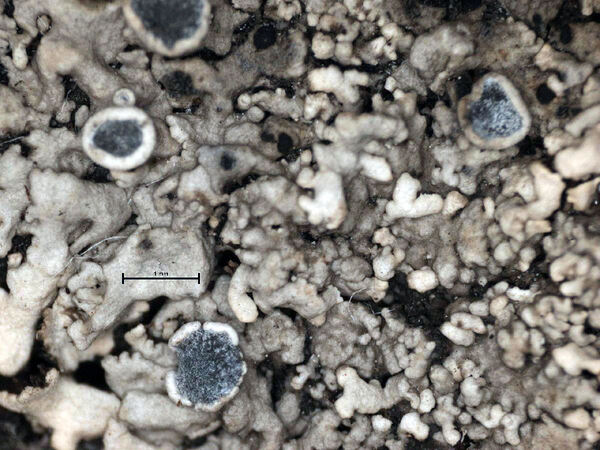Arthonia destruens Rehm
in Rabenhorst, Lich. Eur. Exs.: nr. 816, 1868.
Synonyms:
Distribution: C - Marc (Brackel 2015, 2016), Abr (Brackel 2015, 2016). S - Si (Brackel 2008b, 2016).
Description: Thallus inapparent, not lichenized, developing on the thalli of species of Physcia. Apothecia arthonioid, scattered to clustered in cushion-like groups of c. 10, often confluent, rounded to slightly irregular in outline, 0.l-0.25(-0.4) mm across, erumpent from the host thallus and becoming sessile, black, with a rough surface, in section 50-100 μm tall. Thalloconidia rarely formed at the periphery of the apothecia, roundish, aseptate, c. 3.5-5 um across. Proper exciple poorly developed, formed by a down-turning of the epithecium; epithecium yellowish brown, 5-15 μm high, covered with a c. 5 μm high, hyaline gelatinous coat, I+ blue; hymenium yellowish brown, 25-50 μm high, I+ and K/I+ blue, K+ purplish violet (yellowish parts); paraphysoids scanty, occasionally branched and anastomosing; hypothecium dark brown with a yellowish hue, 20-45 μm high, I+ reddish brown, K/I+ blue, K+ purplish violet. Asci 4-8-spored, broadly clavate, semi-fissitunicate, with a large apical dome and a distinct ocular chamber, Arthonia-type, lacking any I+ or K/I+ structures, 29-43 x 11-15 μm. Ascospores (1-)2-septate, slightly constricted at septum, with a slightly larger upper cell, hyaline to brown when overmature, oblong-ovoid, 10-17 x 5-7 μm, the wall of mature spores finely verrucose. Photobiont absent. Spot tests: thallus K-, C-, KC-, P-, UV-. Chemistry: without lichen substances.Note: a lichenicolous fungus whose known hosts, in the narrower concept of Grube & al. (1995), are Physcia aipolia and P. stellaris; a rare species, perhaps more widespread in Italy than the few records would suggest.
Growth form: Lichenicolous fungus
Substrata: bark
Reproductive strategy: mainly sexual
paras Physcia spp.
Commonnes-rarity: (info)
Alpine belt: absent
Subalpine belt: absent
Oromediterranean belt: absent
Montane belt: rare
Submediterranean belt: rather rare
Padanian area: extremely rare
Humid submediterranean belt: very rare
Humid mediterranean belt: very rare
Dry mediterranean belt: absent

Predictive model
Herbarium samples
Growth form: Lichenicolous fungus
Substrata: bark
Reproductive strategy: mainly sexual
paras Physcia spp.
Commonnes-rarity: (info)
Alpine belt: absent
Subalpine belt: absent
Oromediterranean belt: absent
Montane belt: rare
Submediterranean belt: rather rare
Padanian area: extremely rare
Humid submediterranean belt: very rare
Humid mediterranean belt: very rare
Dry mediterranean belt: absent

Predictive model
| Herbarium samples |


